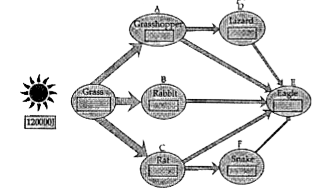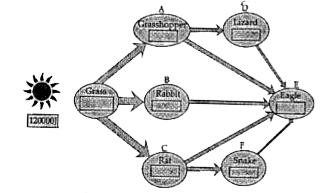For their energy demnds, organisms at each tropic level depend on those at the
Lower tropic level
Higher trophic level
Any trophic level
Sunlight
The correct Answer is:A
For their energy demans , organisms at ech trophic level depend on those at the lower tropic level.
Topper's Solved these Questions
- ECOSYSTEMBOOK - A2ZCHAPTER - ECOSYSTEMEXERCISE - Section A: Topicwise Questions (topic 5: Ecological Pyramids)
14 Videos
- ECOSYSTEMBOOK - A2ZCHAPTER - ECOSYSTEMEXERCISE - Section A: Topicwise Questions (topic 6: Ecological Succession) Succession Of Plants
20 Videos
- ECOSYSTEMBOOK - A2ZCHAPTER - ECOSYSTEMEXERCISE - Section A: Topicwise Questions (topic 3: Decomposition)
15 Videos
- BIOTECHNOLOGY: PRINCIPLES AND PROCESSESBOOK - A2ZCHAPTER - BIOTECHNOLOGY: PRINCIPLES AND PROCESSESEXERCISE - Section D: Chapter-end Test
50 Videos
- ENVIRONMENTAL ISSUESBOOK - A2ZCHAPTER - ENVIRONMENTAL ISSUESEXERCISE - Section D : Chapter-end Test
50 Videos
Similar Questions
At each trophic level the energy value :
View SolutionFood chains and the energy flow within an ecosystem provide an important understanding of contingencies and mutual dependencies of organisms. The given below flow chart depicts the energy flow within some members of a grassland ecosystem. The grass in the below ecosystem transducer 120,000 J of sunlight and fixes it into 12,000 J of energy. It is established that 90% of the energy of one trophic level is not passed to the next trophic level. Further assume that the energy transferred from one trophic level to the next is equally shared among the different organisms at that trophic level.

Based on the above information, indicate the amount of energy that an organism C may have received from an organism from the previous trophic level.
View Solution
Knowledge Check
Read the following statements.
(i) Removal of tigers from an area will result in increased growth of vegetation of that area.
(ii) Organisms at each trophic level depend on those at the lower trophic level for their energy demands.
(iii) Food chains are sustained by producers and decomposers
(iv) In a food chain , some organism like sparrow operates at one trophic level only.
Select an option which shows CORRECT statements.A(i) and (ii)B(ii) ad (iv)C(ii) and (iii)D(i) , (iii) and (iv)Consider the following for statements (1 - 4 ), select the correct option starting which ones are true (T) and which ones are false (F)
(1) An orgenism at each trophic level depends on those at a higher energy demands.
(2) Each trophic level has a certain mass of living material at a particular time called standing state .
(3) Each trophic level has a certain mass of non-living material at a particular time called standing state .
(4) The number of trophic levels in a grazing food chain is not restricted.A1–T , 2 – T , 3 – F ,4 –FB1– F , 2 – T , 3 – F ,4 –TC1– T , 2 – F , 3 – T ,4 –FD1– F, 2 – T , 3 – T ,4 –FOrganisms of the same trophic level are
Adeer and honey beeBcheetah and wild bearCsnake and earthwormDcrow and cow
[A] : In a food chain , membrane of successive higher levels are fewer in number .
[R] : Number of organisms at any trophic level depends upon the availability of organisms which serve as food at the lower level .
View SolutionFood chains and the energy flow within an ecosystem provide an important understanding of contingencies and mutual dependencies of organisms. The given below flow chart depicts the energy flow within some members of a grassland ecosystem. The grass in the below ecosystem transducer 120,000 J of sunlight and fixes it into 12,000 J of energy. It is established that 90% of the energy of one trophic level is not passed to the next trophic level. Further assume that the energy transferred from one trophic level to the next is equally shared among the different organisms at that trophic level.

Which organism acts as both the secondary consumer and the tertiary consumer?
View SolutionOrganisms of the same trophic level are
View SolutionAssertion (A) : In a food chain members of successive higher levels are fewer in number.
Reason (R ): Number of organisms at any trophic level depends upon the availability of organisms which serve as food at the lower level.
View SolutionEach succesive tropic level has
View Solution